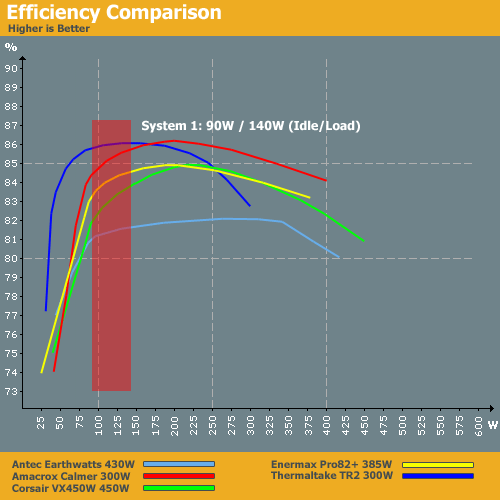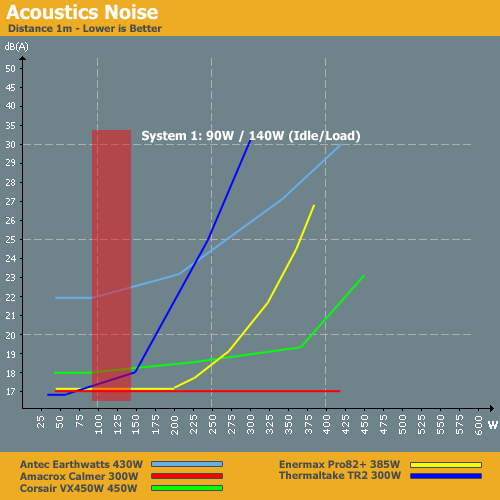Debunking Power Supply Myths
by Christoph Katzer on September 22, 2008 3:00 AM EST- Posted in
- Cases/Cooling/PSUs
Making Compromises
What we have learned from the preceding PSU example? A higher rated power supply will run much quieter if it runs at less than 50% of its rated output, but you don't want the rating to be too high or else efficiency will drop. Now we come to the more complicated part of choosing the right power supply for a new system. You need to make compromises between achieving optimal efficiency and maintaining a quiet working environment. If that is your goal, our high-end sample system is a perfect candidate for a 900W power supply like the Cooler Master UCP 900W. Efficiency is very good throughout the operating range and noise levels will be far lower than the ambient noise from the rest of the system. What we want to do now is go through the three sample systems and select an appropriate power supply.
Our entry-level system has very low power consumption, and unfortunately most power supply manufacturers completely ignore this market segment. Our goal today is to focus on quality power supplies that are readily available worldwide, and most manufacturers start with 500W models and go up from there. That limits our choices, but there are still a few options.
We can only be sure about efficiency if we've tested a power supply, so we will confine ourselves to such units. (Note that we have not necessarily published reviews on all of these power supplies, but we have tested them.) Our entry-level system uses an ATI Radeon HD 3650 graphics card, which means we don't need a PEG connector; that makes our choices a little easier. We'll focus on the following offerings:
- Thermaltake TR2 QFan (300W) actively cooled
- Enermax Pro82+ (385W) actively cooled
- Amacrox Calmer 560 (300W) passively cooled
- Corsair VX450W (450W) actively cooled
- Antec Earthwatts (430W) actively cooled

In the range of 90W to 140W, it's little surprise that the best efficiency is achieved by the two power supplies with the lowest rating (300W). The Thermaltake TR2 QFan places first in our results, and second place goes to the Amacrox Calmer 560. The Enermax takes third place, Corsair is in fourth, and Antec ranks at the bottom of these five options. If it were possible to find a 250W power supply with similar performance at a lower price, that would be even better, but it's just not possible these days. That takes care of efficiency, but let's look at noise levels.

In the same range of 90W to 140W, the Amacrox Calmer 560 and Enermax Pro82+ are the best performers, with the overall crown going to Amacrox, since the Calmer 560 is passively cooled. The Thermaltake TR2 QFan and Corsair VS450W aren't too far behind, at only 18 dB(A) max, while Antec brings up the rear again.
Looking at the above two charts, the Thermaltake TR2 QFan is a perfect candidate for our entry-level system. However, if you instead prefer silence, we would go ahead and pick up the Amacrox Calmer 560. The HD 3650 is also available with passive cooling, so you will never have to complain about computer noise. In fact, I have that exact setup and use it daily as my system for web surfing and writing articles.
As the graphs show, there's still plenty of performance available, so we could even make a few system upgrades down the road. In truth, we could run this sort of system with a 200W power supply, but there are no quality PSUs available in that range. The desire for quality is what led us to select the Amacrox, Thermaltake, Enermax, Corsair, and Antec offerings, as they all provide excellent voltage regulation and overall quality.










98 Comments
View All Comments
Christoph Katzer - Monday, September 22, 2008 - link
Yes I guess that was the problem. Thanks for pointing that out!ViRGE - Monday, September 22, 2008 - link
Christoph, thanks for the excellent article. There is one thing I noticed however that has me a bit confused. In a few of your video card tests, you have the cards pulling upwards of 100 watts from the PCIe slot. It has been my understanding, and is mentioned in AT's X38 chipset article*, that the limit for a PCIe slot is 75W. Your results put this value in contention, so I'm not sure what to believe at this point.Is it that I am mistaken that the limit is 75W, or are your video cards pulling too much power from the slot, or is there a problem with the data?
Christoph Katzer - Monday, September 22, 2008 - link
Thanks. The data is correct since the cards draw power through the PCIE slot and the additional PEG connectors (6-pin or 8-pin). Towards the end of the article you will find a list which card drew how much power from the PCIE slot and the PEG connector. 75 watts is however correct for the older PCIE slots, PCIE2.0 can draw up to 150 watts.mobutu - Monday, September 22, 2008 - link
Where is AMD 4850?Also almost all the graph cards used are kind of old, previous generation.
Dobs - Monday, September 22, 2008 - link
Here is a link to a comprehensive list of all graphics cards.Dobs - Monday, September 22, 2008 - link
damn... link didn't workCopy and paste :)
http://archive.atomicmpc.com.au/forums.asp?s=2&...">http://archive.atomicmpc.com.au/forums.asp?s=2&...
Clauzii - Monday, September 22, 2008 - link
Nice lists, thanks :)Christoph Katzer - Monday, September 22, 2008 - link
As stated I didn't have all of the new stuff here and this article anyway focuses primarily on power supplies and how to choose them and not the power consumption of the components... but it might come soon, who knows.LTG - Monday, September 22, 2008 - link
>>our labs don't have the latest GPUs available for testingIsn't this kind of a bad thing for a site with so many enthusiast readers?
First two caveats:
1) There are a lot of article bashers out there who nit-pick, give rude feedback, or are just plain wrong, I don't support these guys or want to be one.
2) The article written was very good and helpful, thank you.
However it doesn't matter that the article "primarily focused on how to choose power supplies".
- Leaving out a GTX 280 was a big omission. Even better to have an stock OC'd product.
- Leaving out very basic overclock numbers was a big omission. For example it's very common for readers to have an Intel QC clocked at 3.6Ghz since it's so doable.
Having the last two data points would be very helpful for those building top systems, and would even be interesting for those who are not.
7Enigma - Monday, September 22, 2008 - link
As mentioned, the article is about the myth that we all need 1k PSU's for the "best experience". Bottom line this article shows that the vast majority of people do not need more than a 500-600w psu. How is leaving out any stock product an omission? Just look at the TDP of the product and go from there. All stock products will fall within a narrow range.Once you get to OC'ing I also think this is a difficult thing to do. Individual chips, even from the same batch can have very different properties and require different voltages to reach the same speeds. I'm sure if the author had put that his Intel quad drew 120w at 3.6GHz, someone would have complained that their's took 135w, and someone else only 110w...Once you go above stock, it is not cut and dry and as the article states you should have a 20-30% extra buffer if you wish to OC.
I feel the scope of the article just doesn't require these extra requests. Sure it would be nice to see just how crazy of a system you can make (if I remember correctly they did that a while ago to actually use the >1000w supplies), but this article was to show what a normal base, mid-grade, and high-end setup would require.
I've complained in the past about articles, but this one I don't see any serious faults.